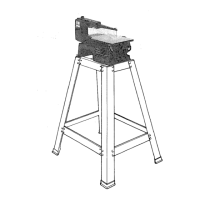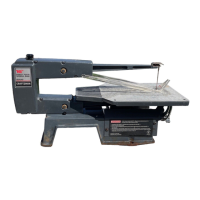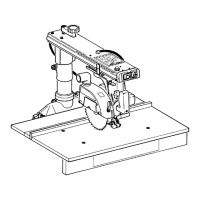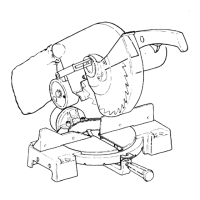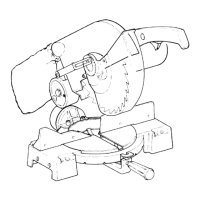trouble shooting
Figure 72
Yoke Clamp Handle Adjustment.
The normal locking position of the yoke clamp
handle (figure 70) is approximately midway
between the two sides of the yoke. When
sufficient wear has occured to permit the handle
to move considerably to the rear, or strike the
yoke before locking, the handle may be adjusted
as follows:
(1) Set the yoke clamp handle to "Normal Locking
Position" (figure 66) which is just slightly ahead of
the mid-position of the handle.
(2) Remove the carriage stop screw and Iockwasher
(figure 71) with a 1/4-inch hex-L wrench.
(3) Grasp the motor and cariage assembly and,
holding it parallel to the radial arm until all
bearing rollers are free of their tracks, move it
carefully off the end of the arm.
(4) Rest the motor and carriage assembly on saw table
and remove the lock screw (figure 72),
(5) Using a screwdriver, rotate the yoke clamp
assembly (figure 73) clockwise until the next hole
will line up with the lock screw. (See figure 72.)
Usually rotating the yoke clamp assembly one hole
will corect this adjustment. However, in some
extreme cases it may be necessary fo rotate it two
holes or more.
(6)
(7)
(8)
Install and tighten the lock screw, (See figure 72.)
Hold the motor and carriage assembly parallel to
radial arm and start the rear bearings onto the
tracks. Continue to hold the assembly parallel to
the tracks until the forward bearings are on the
tracks.
Slide the cariage rearward on the radial arm and
install the carriage stop screw and Iockwasher
(figure 71).
3. BLADE "'HEELS" TO THE RIGHT OR LEFT.
"Heeling" is a term used to describe a condition where
the saw blade is not aligned with the direction in which
it is forced to travel. Figure 74 is a diagram showing
the saw blade "heeling" to the right. Results of
"Heeling", even to a minor degree, can be detected by
the tooth marks left on the edge of the saw kerf (cut
edge) of the board. When using a hollow ground blade,
even a small degree of "heel" will cause the wood to
smoke as a result of the frictional heat produced. The
various effects of "heel" are as follows.
YOKE CLAMP
ASSEMBLY
__LEFT-HAND
24
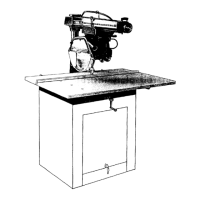
